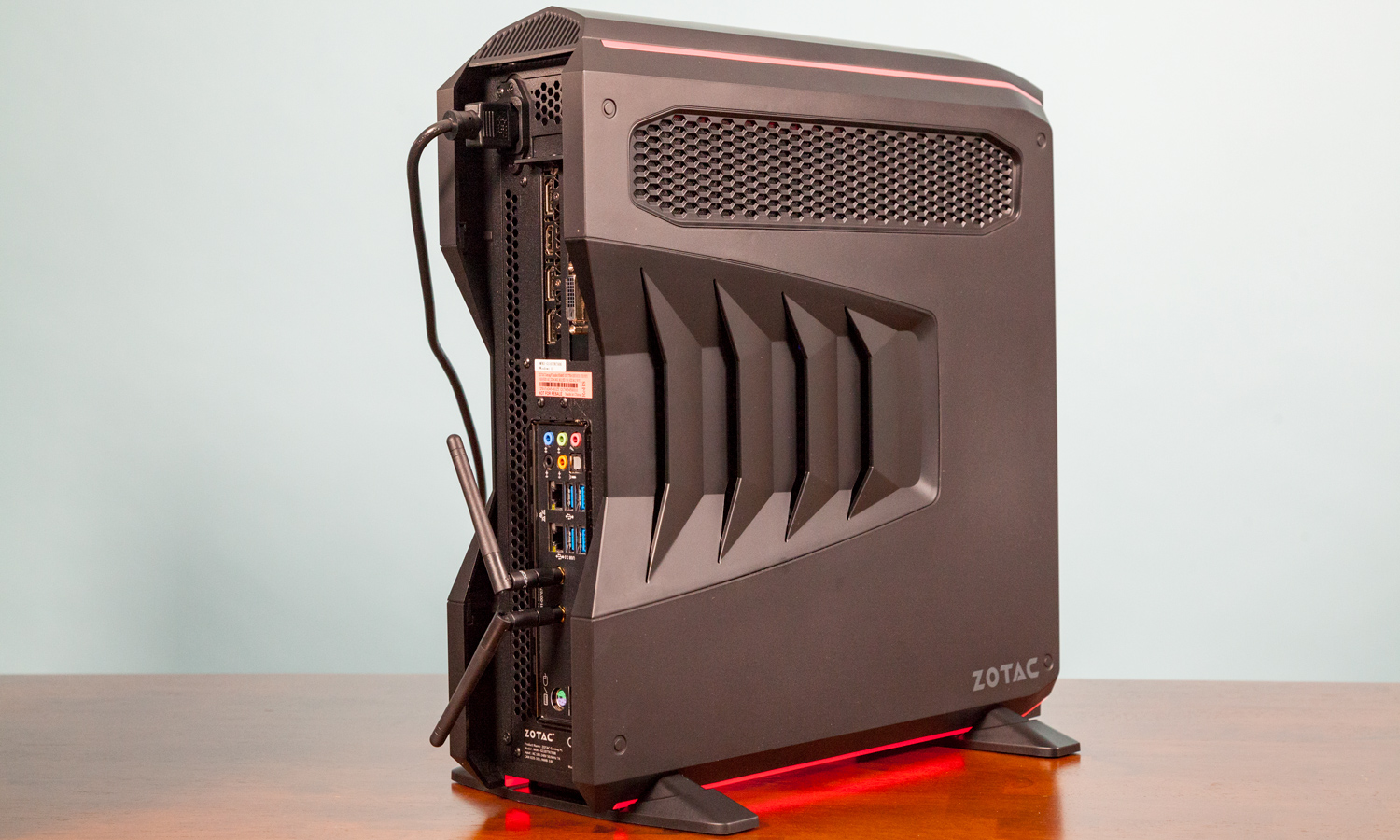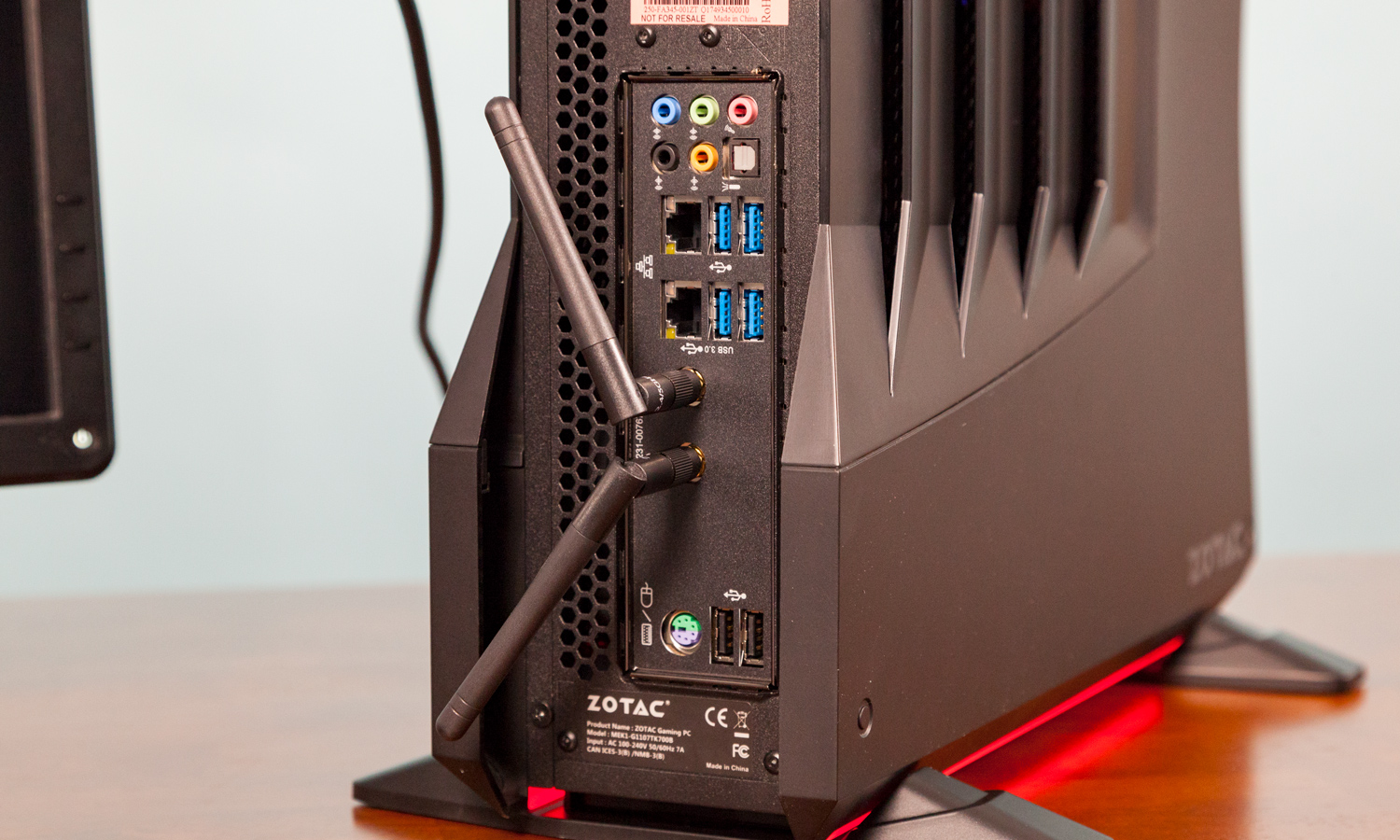Tom's Guide Verdict
The Mek1 is a lean gaming rig that's thinner than the competition and comes with solid peripherals, but it's hard to upgrade.
Pros
- +
Thin
- +
Great design
- +
Solid peripherals
- +
No bloatware
Cons
- -
Hard to upgrade
- -
Gaming performance could be stronger
Why you can trust Tom's Guide
Your gaming desktop doesn't need to be chunky. Zotac's debut gaming tower, the Mek1, is a slick, thin rig, armed with an Nvidia GTX 1070 Ti and a slew of surprisingly good peripherals. It's not as easy to upgrade as larger PCs (though it is possible), but it can match many of them in graphics muscle and won't take up nearly as much room.
Design
The Mek1 is sleek — there's no other way to put it. Despite being all-black and plastic, it stands out because of its angular profile and the fact that it's just so darn thin. The 16.5 x 16.3 x 4.7-inch PC should fit on any desk because it doesn't take up all that much room.
The front of the PC features Zotac's Mek-series logo and a sliding door that hides the power button and a few ports. When the door is closed, the Mek maintains its minimalist profile. The sides of the Mek1 are covered in vents and fans — at its size, it really needs those to keep cool.

There are two LED stripes on the desktop that you can control with Zotac's Spectra app, which lets you control the color (anything on the RGB spectrum) and switch between static, strobe, breathing and cycling lighting modes.

Zotac includes stands in the box to keep the Mek1 upright, but you can also lay it down and use it horizontally if you prefer.
The Dell XPS Tower and MSI Infinite are much bigger, at 15.2 x 14 x 7 inches and 19.2 x 17.7 x 8.3 pounds, respectively.
Key Specs
| Price | $1,599.99 |
| CPU | Intel Core i7-7700 |
| GPU | Nvidia GeForce GTX 1070 Ti (8GB) |
| RAM | 16GB |
| Storage | 1TB HDD, 240GB SSD |
| Size | 16.5 x 4.7 x 16.3 inches, 15.9 pounds |
Ports and Upgradeability
The Mek1 is thin, but there's still plenty of room for ports. On the front, behind a sliding door you'll find two USB 3.0 ports, and headphone and microphone jacks.
Get instant access to breaking news, the hottest reviews, great deals and helpful tips.

Everything else is on the back, including four more USB 3.0 ports, two USB 2.0 ports, dual Ethernet jacks, optical audio, PS/2 ports for legacy accessories and HDMI, DisplayPort and DVI to connect monitors.

Upgrading is a tricky proposition. While many gaming desktops are moving to hand screws, the Mek1 still requires you to use tools, including a Phillips head screwdriver to remove the side panels from the Mek1. Memory and storage are easier upgrades, but the CPU cooler inside was designed specifically for the i7-7700 CPU, so that is a more difficult upgrade without buying new parts and hoping they fit. The GPU is one of Zotac's own cards, which should be simple enough to switch out, but you won't want to go beyond the demands of the 450-watt power supply.
Gaming Performance
With an Nvidia GeForce GTX 1070 Ti inside, the Mek1 is more than powerful enough to play the latest games at 1080p, or perhaps even a bit higher.
I played Middle-earth: Shadow of Mordor on the Mek1 and managed to squeeze out some 4K goodness. On medium settings, the game played between 32 and 37 frames per second, and I stealthily hunted orcs from bushes around their camp. At high settings, it dropped to 31 fps, and ultra went under 30 fps. The game was smoother at 1080p, playing on ultra settings between 74 and 80 fps while I battled a crowd of orcs who had caught on to my sneaky tactics.

On the Hitman benchmark (very high, 1080p), the Mek1 reached 94 fps, which is high for gaming desktops (90 fps), but below the Infinite (123 fps; GTX 1080). It was also the only game we tested that was playable in 4K, running at 51.9 fps at that resolution.
Zotac's PC faltered a bit on Rise of the Tomb Raider, reaching 59 fps. That's still playable, but it fell below the XPS Tower (64 fps; GTX 1070), Infinite (65 fps) and the average (72 fps).
Metro: Last Light ran at an extremely smooth 128 fps on the Mek1, which is far faster than the Infinite (87 fps) and the average (72 fps).
Overall Performance
The Mek1's Intel Core i7-7700 CPU, with 16GB of RAM, a 240GB SSD and 1TB HDD, make for a solid workhorse. I had 30 tabs open in Chrome, including one with a 1080p stream of Fortnite on Twitch, without any issues at all.
On the Geekbench 4 overall performance benchmark, the Mek1 notched a score of 16,599, surpassing the Infinite (16,237; Core i7-7700) but falling short of the gaming desktop average (18,447) and the XPS Tower (22,124 with an 8th Gen Intel Core i7-8700 CPU).
MORE: The Best Gaming Desktops Available Now
The Mek1's 240GB SSD took 18 seconds to copy 4.97GB of files, which translates to a speed of 282.7 MBps. The average gaming desktop is faster (418.5 MBps), as is the Infinite (552 MBps, 512GB SSD).
Peripherals
While most gaming desktop vendors include a cheap mouse and keyboard that you'll need to replace immediately for any serious gaming, the Mek1 includes quality peripherals you might consider keeping around.

You get a mechanical gaming keyboard with Cherry Blue switches, which is extremely rare as a pack-in item. With 3.7 millimeters of travel and 72 grams of force required to press, it's good enough that I reached 107 words per minute on the 10fastfingers.com typing test, though my error rate jumped an extra point to 3 percent. The keys aren't as solid as I'm used to, but I could see using this until I finally got something better.

The mouse is fine, though not as good. The optical gaming mouse has an adjustable DPI setting and four buttons, and I used it for a while with no discomfort. But ultimately, I imagine most will switch this out. You also get a mousepad in the box.
If you're worried about Wi-Fi signals, the Mek1 also includes some antennas in the box for a stronger connection.
Software and Warranty
Zotac offers just one piece of software, Spectra, which controls the lighting and shows you CPU fan speeds and both CPU and GPU temperatures.
Otherwise, the only junk are the same apps built into Windows 10 on every PC, like Candy Crush Soda Saga, March of Empires: War of Lords, Bubble Witch 3 Saga, Drawboard PDF, Plex and Spotify.
Zotac sells the Mek1 with a two-year warranty, and the included peripherals are covered for one year.
Configurations
Our $1,599 review unit came with an Intel Core i7-7700 processor, 16GB of RAM, an Nvidia GeForce GTX 1070 Ti GPU with 8GB of VRAM, a 1TB, 5,400-rpm HDD and a 240GB SSD.
MORE: The Best Headsets for Immersive Gaming
Zotac also has plans to release the Mek1 in white, with a GeForce GTX 1060 GPU, Intel Core i5-7400 CPU and the same RAM and storage options, but it is not currently available for sale and the company declined to tell us what the price will be.
Bottom Line
Zotac has combined a bunch of powerful components in a surprisingly slim chassis, making the Mek1 a strong first entry into the desktop space. The 1070 Ti graphics card makes the unit a pricey machine, but the PC comes with some decent starter peripherals to help make up the value.
A couple of the performance numbers were a bit lower than I'd hoped, possibly because of heat in the system, but ultimately, you'll be able to play most modern games at 1080p and occasionally 4K at decent settings.
If you don't' mind more size, the Dell XPS Tower ($1,649.99 as similarly configured) is easier to upgrade and has a more recent 8th Gen Intel CPU. But if space is at a premium, the Mek1 will deliver.
Credit: Shaun Lucas/Tom's Guide
Andrew E. Freedman is an editor at Tom's Hardware focusing on laptops, desktops and gaming as well as keeping up with the latest news. He holds a M.S. in Journalism (Digital Media) from Columbia University. A lover of all things gaming and tech, his previous work has shown up in Kotaku, PCMag, Complex, Tom's Guide and Laptop Mag among others.


